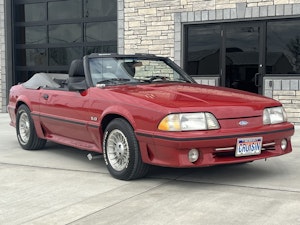Media | Articles
Don’t make these 4 mistakes when flushing your brakes
There is nothing like going for a drive in a classic car, but without brakes that drive would never end—or it would end badly. The best way to keep your car safe and on the road is to engage in some preventative maintenance. It’s not rocket science, and no special tools are required, so set aside a couple hours to check over your brake system and flush the old fluid. Just be sure not to commit these common mistakes.
Mixing brake fluid types
There was a time in the history of automotive production where all brake fluid was created equal, but that is not the case these days. The three most popular brake fluids are DOT 3, DOT 4, and DOT 5. Each has specific applications and should be carefully selected for your application. Consult your service or owner’s manual for the proper brake fluid to add to your system.
Some brake fluids are advertised as being mixable, but if in doubt only add matching fluid. Remember, brakes are nothing to play with. The reasoning behind flushing the old brake fluid is to remove any water content that can lower the boiling point of the fluid, thus reducing the fluids capacity to do its job. Mixing fluids with good intentions might only leave you with more problems, such as failed seals due to using the incorrect type of fluid.
Introducing dirt into the system
The brake system is not like an engine, where there are a multitude of pathways for dirt and grime and weasel their way in. There are only a handful of points where dirt can ingress, and the largest and most common is the brake master cylinder cover. Cars get dirty under the hood (or floor, or trunk, depending on where your master cylinder is located), and a quick wipe to remove any loose debris before removing that cover can save you the headache of fishing out dirt, gasket material, or other detritus that could fall into the system.
Marketplace
Buy and sell classics with confidence
The same goes for opening any bleeder valves or if a brake line needs to be removed. Clean first, then disassemble. It only takes a second and will keep the components of your brake system functioning as long as possible.
Stripping the bleeder
The old saying is if you play with fire, you’ll get burned. When applied to vintage cars, it becomes if you do your own work, you will strip a fastener. Brake work is an area where stripping hardware gets extremely frustrating very quickly.
My tip: Use a six-point socket to initially get the bleeder valve loose. An open-end wrench or even a line wrench just don’t have the maximum contact that a six-point socket does. If they are really putting up a fight, penetrating oil is nothing to be scared of. Also, leverage the time-honored trick of tightening the bleeder just a bit to break up the junk in and around the threads before attempting to back it out again.
Getting brake fluid everywhere
Not all brake fluids will strip paint, but it is best practice to act like they do. This is not only when pouring fresh fluid into the master cylinder, but also when it is being pumped out of the bleeders. A tight-fitting hose on the bleeder screws will prevent any air from back-flowing into the system, and it will also prevent any fluid from spraying out and causing damage to surrounding parts.
I covered these tips and more in one of our Hagerty Drivers Club member livestreams. These live streams not only provide how-to tips and tricks, but also insight and discussion from Hagerty’s team of valuation experts, insight and interviews with industry leaders, and more.











I learned this concerning DOT 3 brake fluid while being a GM Training Center Service Instructor in the ’70s …
DOT 3 fluid is hygroscopic. That means it absorbs moisture which makes cast iron wheel/master cylinders rust which contaminates the fluid. But the moisture, because it is made of hydrogen and oxygen, becomes a gas when the brake friction heats it up and that leads to a spongy pedal on brake application. But the part hardly anyone knows is why the fluid can be rusty even in a never opened system. The answer is … because the cast iron cylinders are porous enough to allow moisture to pass through to join with the hygroscopic DOT 3 fluid. But the cast iron is not porous enough to allow the DOT 3 fluid to weep out. RINGGGG! School Bell! You can Go Home now!
PS – Kyle, Please verify my info and then use it to educate, educate, educate all the Car Guys you can. It will make everyone sound really smart! Ha!
can you shed any do s or don’ts with flushing system on a 1955 chevy with alcohol. master cylinder is original, but i am going to rebuild it. I thank fluids were contaminated by adding dot 5 into a 3 . I have already taken master cylinder off, and am waiting for my rebuild kit . Can alcohol (99.9%) be run thru the lines and out the bleeders without any effects on rubber parts in wheel cylinders?